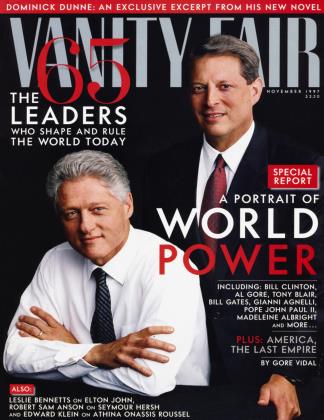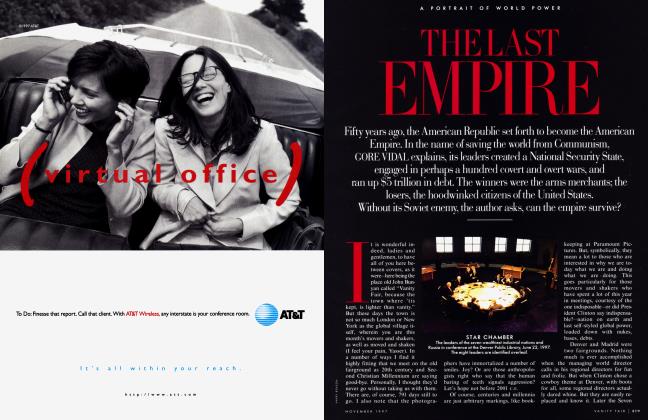Sign In to Your Account
Subscribers have complete access to the archive.
Sign In Not a Subscriber?Join NowEditor's Letter
Elements of Power
A half-century after the Marshall Plan reconfigured the ravaged postwar world, the face of global power has changed profoundly. In the U.S., the clubbable, silver-haired mandarins who assigned the spoils of World War II, and who then built careers around the business of Cold War maintenance, are pretty much a thing of the past. Presidents and pontiffs still draw crowds, but in 1997 the earth's boiler room is run by more quotidian powers: international bankers, conglomerateurs, and Information Age barons driven by commerce rather than commonweal. Their avatars are Agnellis, not Achesons. The Middle East, a power for the past quarter-century, was an afterthought 50 years ago. Russian and Japanese spheres of influence have certainly been on the wane the last decade. A growing power, on the other hand, is South America—long ignored as little more than the U.S.'s basement.
In personal terms, the 65 men and women who make up our "Portrait of World Power," beginning on page 216, rule and shape global destinies in time-honored ways: through action, persuasion, fear, or money. Investor George Soros, for instance, holds no official post, yet he has used his $2.5 billion fortune to change the lives of millions of people in former Soviet satellite countries. And while Nike chief Phil Knight is ostensibly in the shoe business, he is arguably the most powerful person in sports worldwide, his company's elegant swoosh trademark challenging Coca-Cola's logo as an international icon.
For the Vanity Fair staff, the portfolio was an enormous undertaking. The largest stable of photographers we have ever assembled for a single project was dispatched to all parts of the globe, from Moscow's Red Square to 10 Downing Street and the old Fiat factory in Turin. Editor-at-large Matt Tymauer led the V.F. team, with assistance from Riza Cruz, John Gillies, and Chris Lawrence. Photography director Susan White and her crew marshaled the photographers and handled travel and schedule logistics. And art director David Harris and his staff worked long hours to give the 58-page portfolio its sweeping visual impact. For a unique perspective on the last half-century we turned to historian and novelist Gore Vidal, whose waspish, iconoclastic "State of the Union" assessments on the old David Susskind show were mother's milk to interested baby-boomers.
Along the way, we experienced some classic political conflicts. The legendary Russian bureaucracy made it impossible to get a visa in time for contributing photographer Harry Benson to make his appointment with top Yeltsin adviser Boris Berezovsky, but a midnight call to the Kremlin was answered by a refreshingly unbureaucratic woman named Natasha, who managed to get the shoot rescheduled. When we approached China's president, Jiang Zemin, word came down from Beijing that the leader would pose for the portfolio only if we agreed not to run a portrait of the Dalai Lama, symbol of resistance to the continued Chinese occupation of Tibet. We made our decision: Michael O'Neill's portrait of the Dalai Lama appears on page 252, an unposed press shot of Zemin on page 246.
 View Full Issue
View Full Issue












Subscribers have complete access to the archive.
Sign In Not a Subscriber?Join Now